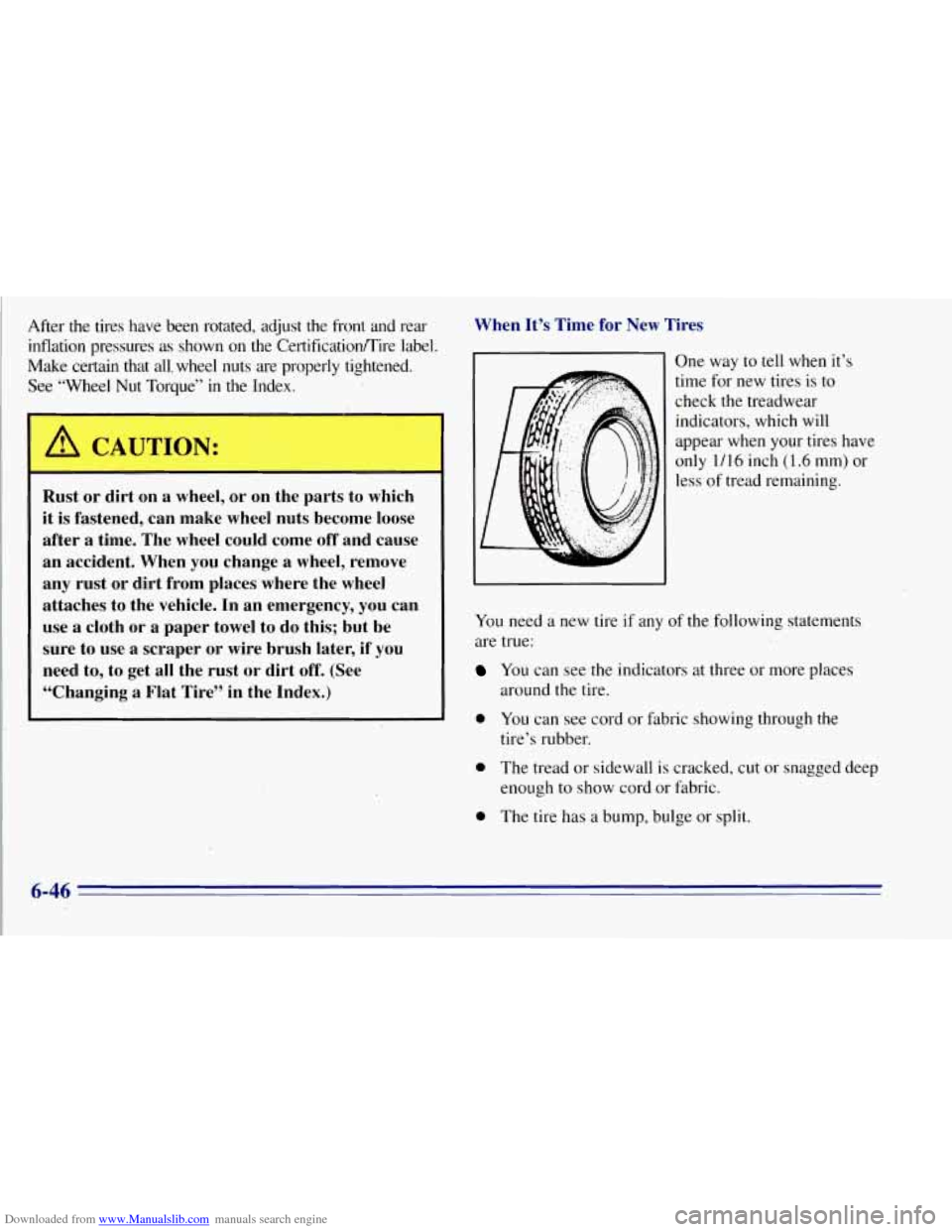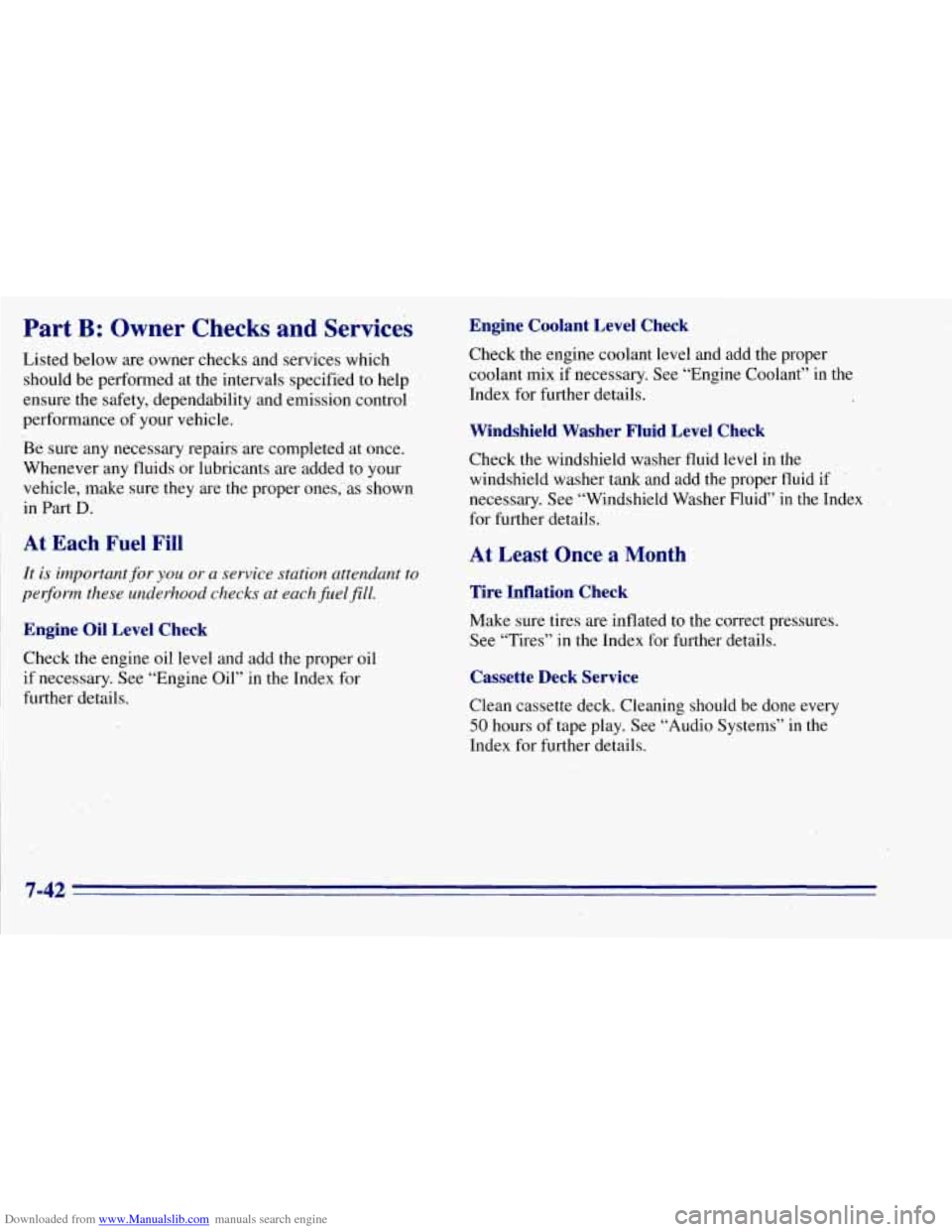1996 CHEVROLET TAHOE inflation pressure
[x] Cancel search: inflation pressurePage 200 of 403

Downloaded from www.Manualslib.com manuals search engine Run your engine only as long as you must. This saves
fuel. When
you run the engine, make it go a little faster
than just idle. That is, push the accelerator slightly. This
uses less fuel for the heat that you get and it keeps the
battery (or batteries) charged.
You will need a
well-charged battery (or batteries) to restart the vehicle,
and possibly for signaling later on with your headlamps.
Let the heater run for awhile.
If you have a diesel engine, you may have to run it at a
higher speed to get enough heat. Then, shut the engine
off and close the window almost all the way to preserve
the heat. Start the engine again and repeat this only
when you feel really uncomfortable from the cold. But
do it as little as possible. Preserve the fuel as long as
you
can. To help keep warm, you can get out of the vehicle
and
do some fairly vigorous exercises every half hour or
so until help comes.
Loading Your Vehicle
nun-
a-n SEE OWNER'S MANUAL FOR ADDITIONAL INFORMATION
The Certification/Tire label.is found on the rear edge of
the driver's door.
The label shows the size of your original tires and the
inflation pressures needed to obtain the gross weight
capacity
of your vehicle. This is called the GVWR
(Gross Vehicle Weight Rating). The GVWR includes
the
weight of the vehicle, all occupants, fuel and cargo.
4-41
Page 297 of 403

Downloaded from www.Manualslib.com manuals search engine Inflation -- Tire Pressure
The CertificationRire label, which is on the rear edge of
the driver’s door, or on the incomplete vehicle document
in the cab, shows the correct inflation pressures for your
tires when they’re cold. “Cold” means your vehicle has
been sitting for at least three hours or driven no more
than
1 mile ( 1.6 km).
You can operate some vehicles at reduced inflation
pressures only when you’ll be carrying reduced loads.
On those vehicles, the minimum cold inflation pressures
for a typical reduced load are printed on the Improved
Ride Tire Pressure label located on the driver’s door.
Weigh the vehicle to find the load on each tire and see
the label
for the minimum cold inflation pressures for
that load.
NOTICE:
Don’t let anyone tell you that underinflation or
overinflation is
all right. It’s not. If your tires
don’t have enough air (underinflation), you can
get the following:
Too much flexing
Too much heat
Tire overloading
Bad wear
Bad handling
Bad fuel economy.
If your tires have too much air (overinflation),
you can get the following:
Unusual wear
Bad handling
Rough ride
Needless damage from road hazards.
6-44
Page 299 of 403

Downloaded from www.Manualslib.com manuals search engine After the tires have been rotated, adjust the front and rear inflation pressures as shown on the Certificatioflire label.
Make certain that all. wheel nuts are properly tightened. See “Wheel
Nut Torque” in the Index.
A
/! CAUTION:
Rust or dirt on a wheel, or on the parts to which
it is fastened, can make wheel nuts become
loose
after a time. The wheel could come off and cause
an accident. When you change a wheel, remove
any rust or dirt from places where the wheel
attaches
to the vehicle. In an emergency, you can
use
a cloth or a paper towel to do this; but be
sure to
use a scraper or wire brush later, if you
need to, to get all the rust or dirt
off. (See
“Changing a Flat Tire” in the Index.) When
It’s Time for New Tires
You need a new tire if any o
are true: One
way to
tell when it’s
time for new tires is
to
check the treadwear
indicators, which will
appear when your tires have
only
1/16 inch (1.6 mm) or
less of tread remaining.
f rh Ile following statements
You can see the indicators at three or more places
around the tire.
0 You can see cord or fabric showing through the
tire’s rubber.
0 The tread or sidewall is cracked, cut or snagged deep
enough to show cord or fabric.
0 The tire has a bump, bulge or split.
6-46
Page 369 of 403

Downloaded from www.Manualslib.com manuals search engine Part B: Owner Checks and Services
Listed below are owner checks and services which
should be performed at the intervals specified to help
ensure the safety, dependability and emission control
performance
of your vehicle.
Be sure any necessary repairs are completed at once.
Whenever any fluids
or lubricants are added to your
vehicle, make sure they are the proper ones, as shown
in Part
D.
At Each Fuel Fill
It is important for you or a service station attendant to
pe$orm these underhood checks at each fuel
fill.
Engine Oil Level Check
Check the engine oil level and add the proper oil
if necessary. See “Engine
Oil” in the Index for
further details.
Engine Coolant Level Check
Check the engine coolant level and add the proper
coolant
mix if necessary. See “Engine Coolant” in the
Index for further details.
Windshield Washer Fluid Level Check
Check the windshield washer fluid level in the
windshield washer tank and add the proper fluid if
necessary. See “Windshield Washer Fluid” in
the Index
for further details.
At Least Once a Month
Tire Inflation Check
Make sure tires are inflated to the correct pressures.
See “Tires” in the Index for further details.
Cassette Deck Service
Clean cassette deck. Cleaning should be done every
50 hours of tape play. See “Audio Systems” in the
Index for further details.
7-42
Page 399 of 403

Downloaded from www.Manualslib.com manuals search engine Tires .......................................... 6-43
Alignment and Balance
........................ 6-49
BuyingNew
................................. 6-47
Chains
..................................... 6-51
Changing a Flat
.............................. 5-19
Cleaning
..................................... 6-57
Inflation
.................................... 6-44
Inflation Check
............................... 7-42
Inspection and Rotation
........................ 6-45
Loading
...................................... 4-41
Pressure
..................................... 6-44
Temperature
................................. 6-49
Traction
.................................... 6-48
Treadwear
................................... 6-48
Uniform Quality Grading
....................... 6-48
Used Wheel Replacement
...................... 6-50
Wear Indicators
.............................. 6-46
Wheel Replacement
........................... 6-49
When It's Time for New
........................ 6-46
TopStrap
..................................... 1-45
Torque Lock
................................... 2-24
Torque, Wheel
Nut ......................... 5-30, 6-70
Towing From the Front
................................ 5-8
From 'the Rear
................................ 5-8
Trailer
...................................... 4-43
Yourvehicle
.................................. 5-6
Brakes
...................................... 4-49
Driving on Grades
............................. 4-51
Trailer
Drivingwith
................................. 4-49
Engine Cooling When Towing
.............. 4-44. 4-53
Hitches
..................................... 4-48
Maintenance When Towing
...................... 4-53 Parking
on Hills
.............................. 4-52
Safety Chains
................................ 4-48
Tongueweight
............................... 4-47
Total Weight on Tires
.......................... 4-47
Towing
..................................... 4-43
Turn Signals
................................. 4-51
Weight
...................................... 4-45
Wiring Harness
............................... 4-53
Transfer Case
.................................. 6-23
Transfer Case, Electronic
......................... 2-19
Transfer Case, Manual
........................... 2-17
Transmitters, Keyless Entry
........................ 2-4
Transportation, Courtesy
.......................... 8-6
Transmission Fluid, Automatic
.................... 6-18
Trip Odometer
.I .................................. 2-57
TTYUsers
..................................... 8-3
Turn Signal and Lane Change Signals
............... 2-29
Turn Signals When Towing
a Trailer ................ 4-51
Underbody Maintenance
........................ 6-58
Underhood Fusemelay Center
............................ 6-66
ReelLamp .................................. 2-37
Storage Area
.................................. 2-47
Vehicle Control
....................................... 4-5
Damage Warnings
.............................. iv
Identification Number ............................ 6-60
Loading
.................................... 4-41
Storage
..................................... 6-35
Ve. ntilation System
............................... 3-7
9-10